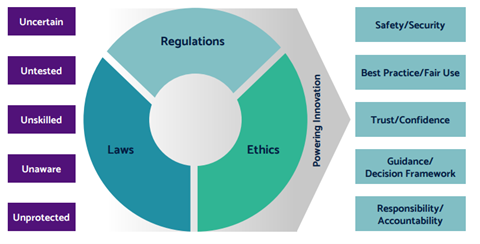Responsibly implementing AI is crucial for businesses to build trust with their customers, protect user privacy, and prevent potential harm. AI governance is how businesses can ensure ethical implementation of AI. When AI governance is carried out correctly, it can be a powerful tool enabling innovation, whereas a lack of governance can often hinder innovation. In this blog post, we explore how organisations can strike the balance between driving innovation and responsibly implementing AI.
What is AI Governance?
AI governance refers to the set of policies, frameworks, and practices that guide the development, deployment, and use of AI technologies. It involves establishing rules, standards, and ethical guidelines to ensure organisations implement AI in a responsible and accountable way. AI governance ensures that the quality of the AI that is implemented is upheld, and all stakeholders have clear communication regarding AI best practice.
“The global AI governance market size was valued at USD 124.3 million in 2022 and is expected to grow at a compound annual growth rate (CAGR) of 35.6% from 2023 to 2030.”
AI Governance - Why is it Needed?
AI governance addresses the potential risks, challenges, and ethical considerations associated with AI. It aims to ensure that AI systems are developed and deployed in a way that aligns with societal values, protects user rights, and minimises potential harm. By using AI governance businesses can stay adaptable and prepared for future changes in AI technology and regulation.
AI governance is a combination of leadership, training, communications, guidance, policies, processes, and tools, aiming to address the three following areas:
- Law – The rules enforced by our legal system.
- Ethics – The rules enforced by culture and society.
- Regulation – The rules enforced by governments.
How Does AI Governance Impact Innovation?
AI governance is an evolving field, as AI technologies continue to advance and new challenges emerge. AI governance aims to strike a balance between innovation and responsible AI use, ensuring that AI benefits society while minimising the potential risks and negative impacts.
When governance is done correctly, it can be a powerful enabler of innovation, whereas a lack of governance can hinder innovation. Clarity is required on the acceptable use of AI to mitigate any fear of wrongdoing. Companies that provide clear guidance on the use of AI, its features, and why it is employed will be able to fully harness the benefits of AI.
What Are The Goals Of AI Governance?
Ensure legal and regulatory compliance – Avoid any consequences that result from not adhering to laws and/or regulations regarding AI.
Protect against reputational damage – Reputational damage could stem from data breaches, or the wrongful or unethical use of AI.
Provide clarity on the acceptable use of AI – Providing accurate information on what AI can be used for and what it cannot be used for.
Provide confidence in the use of AI – AI governance can help in training and providing clear guidance on the use of AI. It can also help to provide confidence in whether AI is the right tool for the job.
Empower users – AI governance can speed up adoption by removing and eliminating fears and can supercharge innovation.
As we innovate, we need to consider the impact we have on both people and the planet and ensure what we are doing reduces this impact as much as possible, and where possible, provides a positive impact to the world we live in for future generations.

The Key Components of Successful AI Governance Implementation
There are several key components of governance required to power innovation. To properly launch AI governance, a clear strategy and goals are required.
Once goals have been set, there is a need for a body of work to ensure the goals are being met, as well as to define and enforce guidelines, and track progress.
Ensure AI best practice can be carried out by collating and sharing accessible training resources for all involved in the AI strategy.
A set of clear rules is required that make it easy for anyone launching new AI initiatives to understand what is acceptable.
Beyond the guidelines and best practice, there must be clear processes to obtain clarity for anything that is not covered by the general guidance.
Finally, you need the systems and tools in place to be able to roll out your initiatives, provision infrastructure and data, measure progress, and ensure that due process is followed throughout. Given how AI learns over time and is therefore dependent on the data it is fed, it is crucial to have clear retention policies in place to be able to audit past decisions.
The Outcomes of Succesful AI Governance Implementation
Successful AI governance implementation can yield numerous benefits for companies. Well-executed AI governance cultivates responsible AI usage, aligns business objectives with societal values, and positions companies as leaders in the responsible and sustainable AI landscape.
AI governance ensures ethical AI development, fostering customer trust and loyalty. Transparent processes improve decision-making, boosting operational efficiency and innovation. Compliance with regulations prevents legal issues, safeguarding the company's reputation.
Learn More About AI Implementation and Governance With BJSS
At BJSS, we recognise the importance of AI governance, our experienced consultants will help you establish policies, frameworks, and ethical guidelines to ensure responsible AI use. Our dedicated Data & AI Centre of Excellence, along with our proven track record of delivering successful AI projects, makes us the ideal choice to help your organisation navigate the AI landscape with confidence. Click here to read our eBook ‘Successful AI Implementation in Business – What are the Key Considerations?’ that explores the considerations of implementing AI and AI governance.Published
April 29, 2024Reading time
3 minutesRelated posts





